|
TennisOne Lessons
Analyzing Pro Strokes: The Philippoussis Serveby Rafael Font de Mora
Last Summer, Mark Philippoussis used his mighty serve as a ticket to his first Wimbledon final. Philippoussis, nicknamed Scud for this fearsome weapon, fired 164 aces on his way to the final. Here is an analysis of this awesome serve. PreparationThe preparation phase consists primarily of the mental ritual in which Philippoussis visualizes the spin, speed, and placement of the serve he is about to deliver. This decision is based upon the positioning and knowledge of his opponent's limitations. Philippoussis holds the ball and racquet out in front of his body, with his weight resting primarily on his front leg maintaining a relaxed body position throughout.
The Wind UpPhilippoussis initiates the action by straightening his back and lowering the racquet as his weight starts shifting to his back leg. Notice how the back heel is flat on the ground and the toes of the front foot are rising. Mark lowers his racquet to start his loop where he generates half of his monstrous power. The kinetic chain starts from the toes up. Notice the width of his stance, which gives him major leverage and balance allowing him to maximize the use of his body. The TossNotice how Philippoussis makes the tossing arm and the racquet work together in perfect synchronization. Most of the recreational players lose power and coordination at this exact point of the swing.
The key is to start this coordinated motion slowly and fluidly to begin speeding up the motion as you get further into the swing. It is important for a consistent serve to have the left arm extended, maintaining it, and not dropping it too quickly. The action of the non-racquet and racquet arm is an example of Newton's third law, which states that every action has an equal and opposite reaction. The action of the left arm balances that of the right arm so that the racquet arm does not initiate unwanted angular momentum (rotation of the upper body). Observe once more his wide stance with a straight back leg activating his gluteus to gain even more height (every inch counts!).
CoilingThe key here is bending the knees in order to store energy for the explosion. This is what enables Phillipoussis to take off from the ground generating a powerful jump into the air. As we mentioned, do not overestimate how important the use of the body is and how tall players can take advantage of the proper use of their bodies. See the extreme knee bend with perfect alignment of his body which, in my opinion, is his best attribute. The motion of the racquet head is crucial to the development of power, consistency, and spin. Notice how he lowers his centre of gravity, then the shifting of his hips and weight from the back foot to the front foot enables him to accelerate the racquet head. Contact and Extension
The striking action and power is initiated via the extension of the legs and the downward acceleration of the tossing arm. By dropping the tossing arm, he achieves force generation along with hip rotation, and increases the angular momentum of his arm. Philippoussis is able to attain a remarkable range of flexibility and motion in both his shoulder and his back. This flexibility enables Mark to achieve a wide and extended loop for maximum racquet head acceleration. Notice how he effectively uses all the links of the kinetic chain, with each of the body's segments becoming smaller while the slower moving and bigger segments (hip and trunk) rotate forward to initiate the force generation of the smaller body segments (arm, forearm, wrist, and racquet). Each of these parts are connected from the ground up and act as third class levers releasing in sequential order of legs to hips, trunk and upper limbs to the racquet, resulting in a whip like action that produces tremendous racquet head velocity.
Follow ThroughProper follow through is the actual result of a sound serving action. The follow through starts after contact. Philippoussis' racquet follows through across the body and decelerates. Notice how Philippoussis chooses to land on the front foot flexing it at the ankle, then lowering the heel to the ground, and flexing at the knees and hips. All of this helps reduce the stress upon the muscles, joints, and bones. This sequence is difficult to watch at normal speed, but is worthwhile observing frame by frame in the video below. By following through this way, Mark manages to convert the angular momentum into linear momentum. Also notice how well he maintains his balance with the weight completely on the front leg and a low center of gravity. This gives him the dangerous option to kill his opponent with a ferocious groundstroke or a put away volley.
Your comments are welcome. Let us know what you think about Rafael Font de Mora's article by emailing us here at TennisONE
|

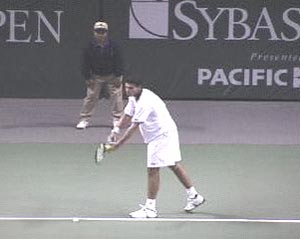
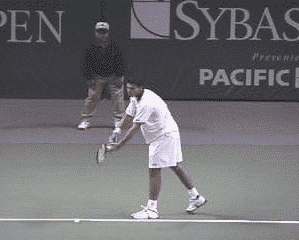
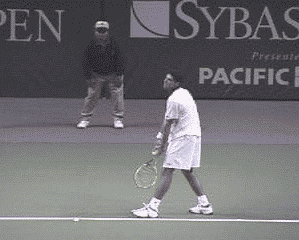
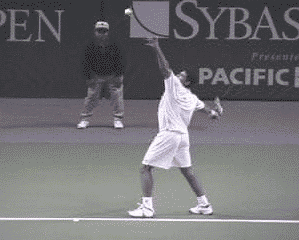
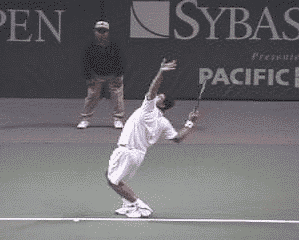
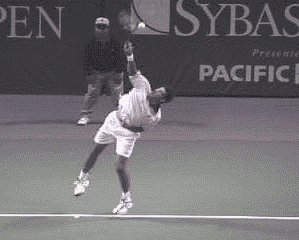
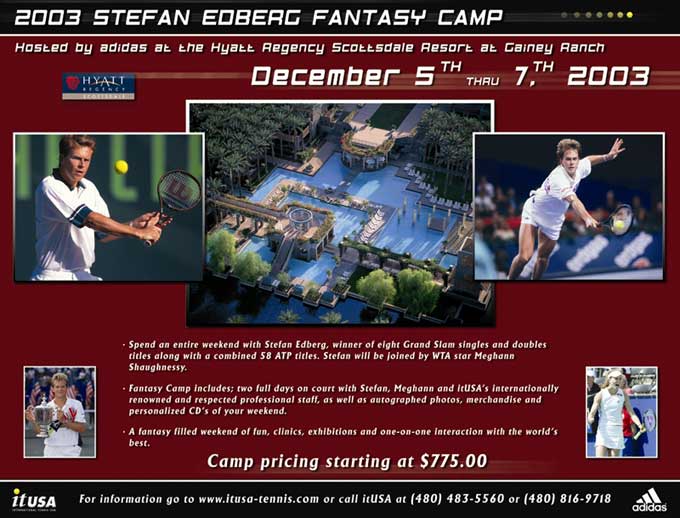
 Rafael Font de Mora was born in Valencia, Spain. He competed on the men's professional tennis tour from 1985 through 1988 and was a tennis analyst for NBC during the Barcelona Olympics.
Rafael Font de Mora was born in Valencia, Spain. He competed on the men's professional tennis tour from 1985 through 1988 and was a tennis analyst for NBC during the Barcelona Olympics.